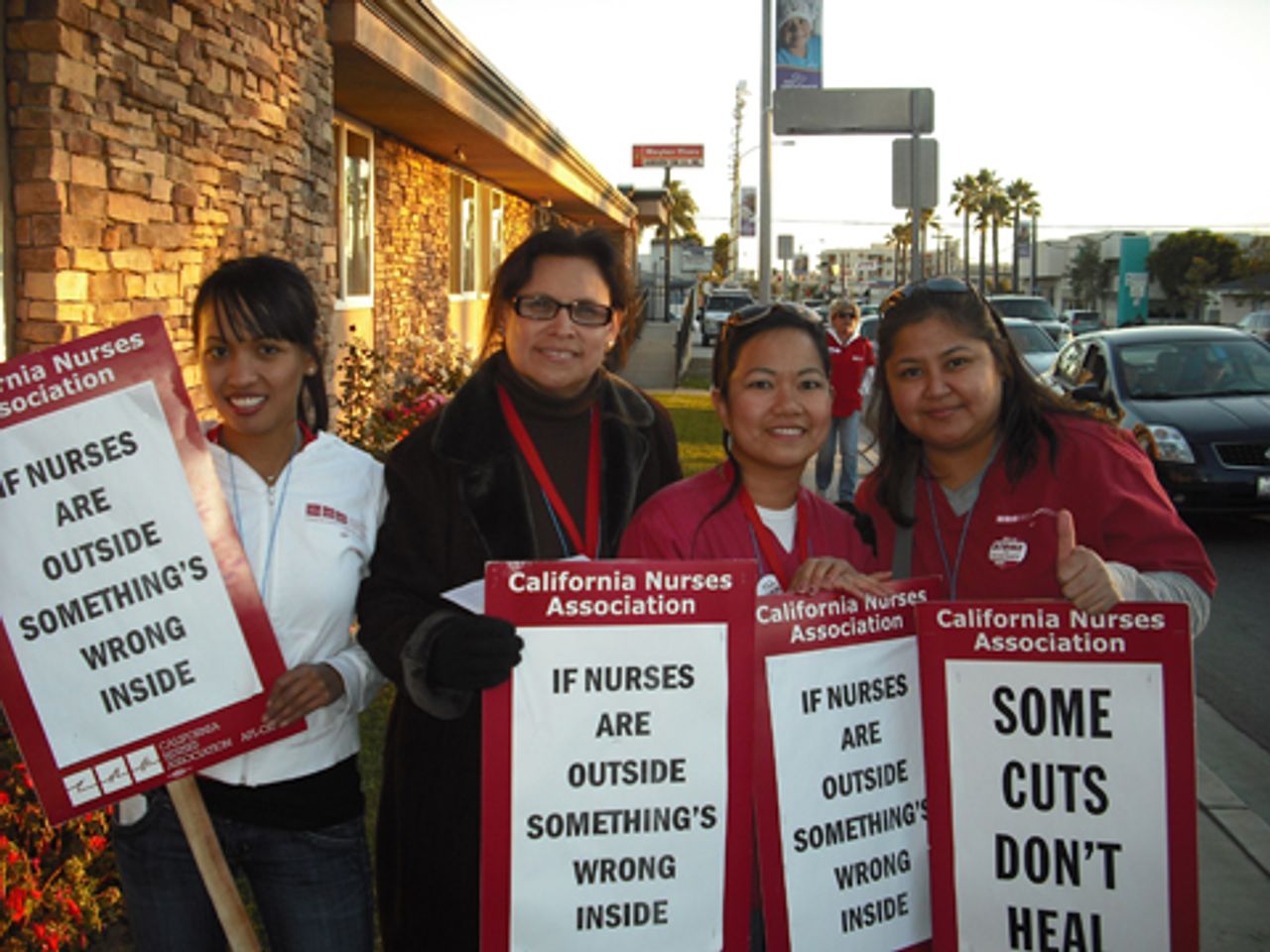 Cecilia Gasparian (second from left)
Cecilia Gasparian (second from left)
Some 6,000 nurses in California went on a one-day strike on Thursday December 22. The nurses are demanding decent staffing levels, health benefits, and sick leave.
The protest affected eight for-profit San Francisco Hospitals, all owned by Sutter Corporation, and the Long Beach Children’s Hospital complex in Southern California, also privately operated but not by Sutter. At the Long Beach protest, nurses were also demanding lifting teams for heavy patients and regular breaks.
As in previous struggles, by limiting the protest to a one-day strike at a few hospitals, the nurses unions, the California Nurses Association and the National Nurses United, are paving the way for givebacks and defeats.
Both hospital corporations responded to the protest by punishing the nurses for their job action—in Long Beach by locking them out until Tuesday, December 27, and until Saturday for Sutter nurses. The hospitals enforced the lockout on the pretext that they could not hire replacement nurses for only one day.
Spokespersons for Sutter attempted to minimize the impact of the protest, claiming that more than half the nurses had not participated in the strike in hospitals in Antioch and Castro Valley, but gave no precise numbers.
The California strike took place a day after nurses in New York City demonstrated in Wall Street against Cerberus Capital Management, whose health care company, Steward, has engaged in aggressive cost-cutting. One thousand New York City nurses intend to strike on January 3.
On September 22, Sutter hospital nurses also walked out, together with nurses employed by the Kaiser Permanente HMO and Oakland’s Children Hospital.
On Thursday, in Long Beach, hundreds of nurses picketed the Long Beach Memorial Center (LBMC).
At a noon rally, dozens of police were present, in addition to a beefed up force of security officers. Helicopters flying overhead supported the police force. One nurse who spoke to the World Socialist Web Site denounced it as a “criminalization of nursing.”
Tensions were high when, following the rally, the pickets attempted to enter the hospital and were pushed back by the private security force.
Nurses estimated that the cost of extra security and strikebreaking nurses most likely exceeded the cost of agreeing to the nurses’ demands.
The picketers carried signs that demanded rest breaks for nurses, adequate patient-to-nurse ratios, and the elevation of patients before profits.
For the LBMC management, state-mandated nurse to patient ratios are being obeyed by forcing nurses to work 12-hour shifts, often through their lunch and rest breaks.
The World Socialist Web Site spoke to Cecilia Gasparian and María Caro, both cardiac care nurses.
“Our patient to nurse ratio in the Interventional Coronary Care Unit is 3:1, but we cannot refuse extra patients in an emergency,” Cecilia said. “That is ground for termination. We do file an objection, for our protection and for the protection of the patients. For management, money comes before patients; it is profits that count.”
 María Caro
María CaroMaría pointed out that there is a surplus of nurses in California. However, the hospitals resist calling in or hiring extra nurses: “Nurses have been furloughed while other nurses are forced to work through their breaks,” said María. “Over the summer, nurses were furloughed for about 30 days. That is one reason why we feel so strongly about ratios.”
Another major issue at LBMC is the lack of lifting teams to move heavy patients.
“They have four people; they call it a team,” said María. “That is not enough for a hospital this size. Most of the time, it is up to us to lift and turn people, no matter what their size. Management thinks that this is safe. Safe for whom? All this lifting and turning takes a physical toll. A patient that is not turned can get bed sores, blood clots, even pneumonia.”
“Management puts a price on the care of the patient,” María added. “In my 20 years of nursing, the profit motive has always been there. The difference is that today they are cutting to the bone.”
Cutbacks have resulted in the speed-up of nursing and the discharge of patients who are not profitable for the hospital.
“I have attended meetings in which nurses are told to push patients out whose insurance coverage had run out,” Cecilia said. “For the hospital it is about profits. We became nurses to heal people, not for profits.”
As an example María recounted the case of a patient with spina bifida, a serious condition of the spine, who at age twenty-one was transitioned from state benefits for children and teenagers and left with no insurance. At one point she developed a spinal infection that required expensive surgery to repair and could not afford the surgery.
“This is all tied together, the one percent is benefiting. They can afford to get the most advanced therapies. They end up living better and longer than those without insurance and that cannot afford to pay.
“Even when patients get medical care, they often cannot afford the medication. Yet at every point someone is getting rich out of this.”
Many of the nurses are now sole supporters of their families after the layoff of their spouses and other family members.
Thursday’s protest is a reflection of that experience. “We are in an economic crisis,” said Cecilia, “We cannot tolerate the rich getting richer. We became nurses because we love the human race, not getting rich.”
The California Nurses Association and the National Nurses United are keeping the struggle at the level of isolated one-day protests at a few hospitals. The aim of the unions is to let off steam while they negotiate concessions with the companies.
The protests in New York and California take place in the context of a national assault on health care. Driving the attack on nurses and health care workers by hospitals and clinics across the nation is the Obama administration. As part of the health care reforms imposed by the Obama administration and the Democratic-led Congress, each of the nation’s 5,700 hospitals is expected to reduce costs by an average of $2.6 million over the next ten years.
In California, the attack on health care is now being led by the administration of Jerry Brown, also a Democrat. Both big business parties are united in their insistence that workers pay for the budget deficit and the economic crisis. The trade unions, including the nurses unions, support Brown and are determined to keep the struggle of workers from coming into conflict with the Democratic Party.
Subscribe to the IWA-RFC Newsletter
Get email updates on workers’ struggles and a global perspective from the International Workers Alliance of Rank-and-File Committees.
